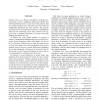Free Online Productivity Tools
i2Speak
i2Symbol
i2OCR
iTex2Img
iWeb2Print
iWeb2Shot
i2Type
iPdf2Split
iPdf2Merge
i2Bopomofo
i2Arabic
i2Style
i2Image
i2PDF
iLatex2Rtf
Sci2ools
CSFW
2009
IEEE
2009
IEEE
Updatable Security Views
Security views are a flexible and effective mechanism for controlling access to confidential information. Rather than allowing untrusted users to access source data directly, they are instead provided with a restricted view, from which all confidential information has been removed. The program that generates the view effectively embodies a confidentiality policy for the underlying source data. However, this approach has a significant drawback: it prevents users from updating the data in the view. To address the “view update problem” in general, a number of bidirectional languages have been proposed. Programs in these languages—often called lenses—can be run in two directions: read from left to right, they map sources to views; from right to left, they map updated views back to updated sources. However, existing bidirectional languages do not deal adequately with security. In particular, they do not provide a way to ensure the integrity of source data as it is manipulated ...
| Added | 20 May 2010 |
| Updated | 20 May 2010 |
| Type | Conference |
| Year | 2009 |
| Where | CSFW |
| Authors | J. Nathan Foster, Benjamin C. Pierce, Steve Zdancewic |
Comments (0)

